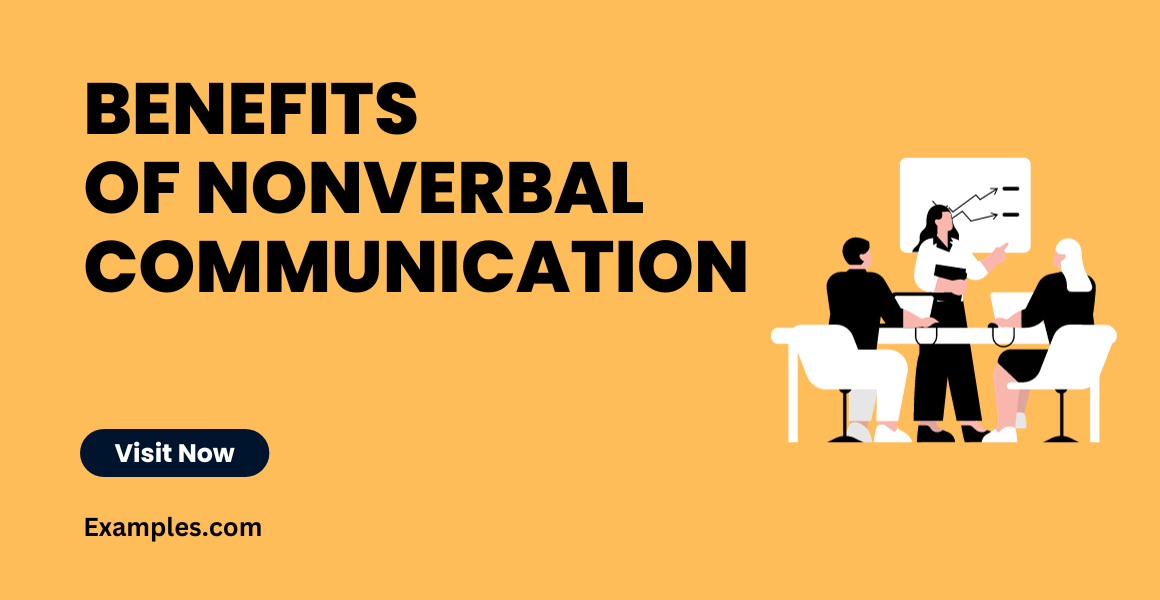Benefits and Uses Nonverbal Communication – Examples, Benefits
In our comprehensive guide to Nonverbal Communication, you’ll discover the profound impact of unspoken interactions in daily life. From subtle gestures to expressive body language, we delve into a variety of Nonverbal Communication Examples that shape our understanding and relationships. Whether in personal connections, the workplace, or diverse cultural settings, this guide illuminates the nuances and importance of nonverbal cues. Uncover the silent yet powerful language that complements and often speaks louder than words.
What are the Benefits of Nonverbal Communication?
Nonverbal communication refers to the way we convey messages without using words. It includes facial expressions, body language, gestures, and even the tone of our voice. The benefits of nonverbal communication are vast and significant in our daily lives. Here are some key advantages:
- Enhances Verbal Messages: Nonverbal cues can add depth and clarity to what we say, making our messages more understandable.
- Expresses Emotions: It’s often easier to show how we feel through our body language or facial expressions than through words.
- Builds Rapport: Nonverbal signals like a smile or a nod can create a sense of connection and trust between people.
- Facilitates Quick Understanding: Sometimes, a gesture can convey a message faster and more effectively than words.
- Cross-Cultural Communication: Nonverbal cues can sometimes be more universally understood across different languages and cultures.
- Indicates Sincerity: Our nonverbal behavior often reveals the truth about our feelings, indicating whether we are sincere or not.
- Helps in Social Bonding: Nonverbal communication is essential in forming bonds, especially in situations where verbal communication might be limited, like with infants or in noisy environments.
In summary, nonverbal communication enriches our ability to interact and understand each other in a way that words alone cannot achieve. It plays a crucial role in enhancing our social interactions and emotional connections.
Benefits of Effective Nonverbal Communication
Effective nonverbal communication is pivotal in enhancing our interactions, contributing significantly to the Benefits of Nonverbal Communication. This form of communication transcends spoken words, encompassing a range of behaviors and signals that deeply impact how messages are received and interpreted. Here are some key benefits:
- Improves Clarity and Understanding: Nonverbal cues, including gestures, facial expressions, and tone of voice, provide additional context to spoken words. They help clarify messages, reduce misunderstandings, and are vital in Nonverbal Communication in Daily Life.
- Enhances Relationships: Effective nonverbal communication fosters stronger connections. Actions like a warm smile or a gentle gesture can build trust and rapport, essential in any relationship, highlighting the Advantages and Disadvantages of Nonverbal Communication.
- Facilitates Emotional Expression: Nonverbal means often convey emotions more effectively than words. Expressions of empathy through nonverbal cues can be more impactful, demonstrating the Characteristics of Nonverbal Communication.
- Aids in Conflict Resolution: Being aware of nonverbal cues in oneself and others can be crucial in resolving conflicts. Understanding underlying emotions and intentions through body language can lead to effective problem-solving.
- Boosts Professional Interactions: In the workplace, nonverbal communication can enhance various aspects like presentations, interviews, and team dynamics. Effective nonverbal skills are essential for leadership, teamwork, and customer relations, underlining the importance of Nonverbal Communication at Workplace.
Benefits of Nonverbal Communication in Business
In the business arena, nonverbal communication is a key component in shaping interactions, negotiations, and leadership dynamics. Its effective use can lead to improved outcomes and stronger business relationships. Here are some key benefits in a business context:
- Enhances Leadership Presence: Effective nonverbal communication, like maintaining strong eye contact and a confident posture, is essential for a leader’s presence and influence, significantly contributing to Nonverbal Communication Skills in leadership.
- Improves Client Relations: Gestures such as a firm handshake, direct eye contact, and an open posture can build trust and rapport with clients, pivotal for Nonverbal Communication in Different Cultures and business contexts.
- Aids in Negotiation: Recognizing and appropriately responding to nonverbal cues during negotiations can provide an advantage, helping to understand unspoken concerns or agreement.
- Facilitates Teamwork: Positive body language in team settings encourages collaboration and fosters a conducive work environment, highlighting the importance of Nonverbal Communication at Workplace.
- Supports Effective Communication: In business presentations and meetings, nonverbal cues like appropriate gestures and facial expressions can reinforce spoken messages and keep the audience engaged.
Benefits of Nonverbal Communication in the Workplace
Nonverbal communication in the workplace is a powerful tool that can significantly influence interactions, team dynamics, and overall organizational culture. Understanding and effectively utilizing nonverbal cues can lead to a more harmonious, productive, and efficient work environment. Here are some key benefits:

- Enhances Team Collaboration: Positive nonverbal signals, like nodding and smiling, can foster a collaborative spirit among team members, crucial for Teamwork and Nonverbal Communication.
- Facilitates Leadership: Leaders who use nonverbal communication effectively, such as maintaining eye contact and open body language, can inspire confidence and respect among employees, a key aspect of Nonverbal Communication in Leadership.
- Improves Conflict Resolution: Recognizing and interpreting nonverbal cues can help in resolving workplace conflicts more effectively, as it allows for a better understanding of unspoken issues and emotions.
- Boosts Employee Morale: Positive nonverbal interactions, such as a pat on the back or a friendly smile, can greatly enhance employee morale and job satisfaction.
- Aids in Effective Communication: Nonverbal cues complement verbal communication in presentations, meetings, and everyday interactions, making messages more clear and impactful.
Benefits of Nonverbal Communication in Healthcare
In the healthcare sector, nonverbal communication is essential for providing compassionate and effective care to patients. It plays a significant role in patient interactions, team coordination, and overall healthcare delivery. Key benefits include:

- Improves Patient Care: Nonverbal cues like a gentle touch or a reassuring smile can make patients feel more comfortable and cared for, which is vital in Patient-Centered Care and Nonverbal Communication.
- Facilitates Healthcare Provider Collaboration: Effective nonverbal communication among healthcare providers can improve teamwork and collaboration, essential for patient safety and care.
- Aids in Diagnosis and Treatment: Observing patients’ nonverbal cues can provide healthcare professionals with important information about their condition, aiding in accurate diagnosis and treatment.
- Builds Trust with Patients: Healthcare providers who are adept at nonverbal communication can build trust and rapport with patients, leading to better patient outcomes and satisfaction.
- Enhances Communication with Non-Verbal Patients: In situations where patients cannot communicate verbally, such as in cases of Nonverbal Communication for Autism or speech impairments, nonverbal cues become crucial in understanding their needs and providing appropriate care.
Both in the workplace and healthcare settings, nonverbal communication offers numerous benefits, enhancing understanding, collaboration, and effectiveness. Its role in complementing verbal communication and providing additional layers of meaning underscores its importance in these professional environments.
Uses of Effective Nonverbal Communication?
Effective nonverbal communication yields numerous benefits in various facets of life, such as personal interactions, professional engagements, and daily communication. Some key benefits include:
- Improved Understanding and Clarity: Nonverbal cues aid in clarifying spoken messages, reducing misunderstandings and miscommunications, a crucial aspect of Nonverbal Communication in Daily Life.
- Enhanced Emotional Connection: Nonverbal communication often conveys feelings more powerfully than words, allowing for deeper emotional connections and highlighting the Characteristics of Nonverbal Communication.
- Increased Persuasiveness: In situations requiring persuasion, nonverbal cues can add credibility to the spoken word, making arguments more compelling.
- Better Conflict Resolution: An understanding of nonverbal signals can be instrumental in resolving conflicts by revealing the true emotions and intentions of the parties involved.
- Stronger Relationships: Building trust and rapport through effective nonverbal communication is foundational for strong, lasting personal and professional relationships.
Effective nonverbal communication, therefore, plays a pivotal role in enhancing understanding, building relationships, and ensuring successful interactions in both personal and professional settings.
In conclusion, understanding nonverbal communication is essential for effective interactions, particularly in enhancing Nonverbal Communication Skills. This guide has provided insights into its benefits, types, and practical examples, offering valuable tips for enhancing communication skills. By mastering both verbal and nonverbal cues, individuals can significantly improve their personal and professional relationships, ensuring clearer, more empathetic, and impactful exchanges.



